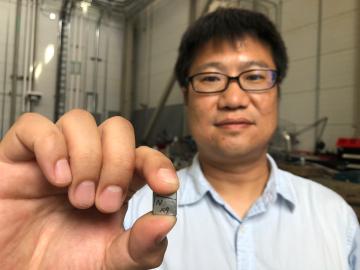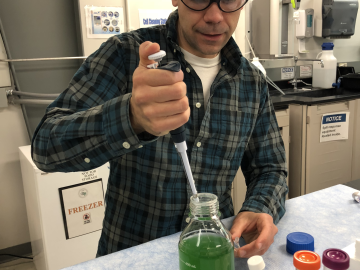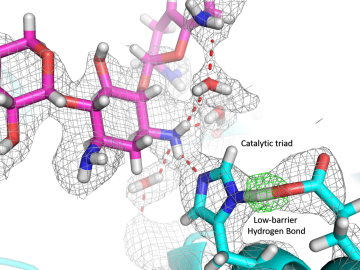Filter News
Area of Research
- (-) Neutron Science (13)
- Advanced Manufacturing (8)
- Biological Systems (1)
- Biology and Environment (18)
- Building Technologies (5)
- Clean Energy (61)
- Computational Biology (1)
- Computational Engineering (1)
- Computer Science (3)
- Electricity and Smart Grid (1)
- Fossil Energy (1)
- Fusion and Fission (3)
- Isotopes (4)
- Materials (24)
- Materials for Computing (9)
- Mathematics (1)
- National Security (2)
- Nuclear Science and Technology (4)
- Quantum information Science (1)
- Renewable Energy (1)
- Sensors and Controls (1)
- Supercomputing (9)
- Transportation Systems (1)
Media Contacts

Neutron scattering techniques were used as part of a study of a novel nanoreactor material that grows crystalline hydrogen clathrates, or HCs, capable of storing hydrogen.

Oak Ridge National Laboratory researchers are developing a first-of-its-kind artificial intelligence device for neutron scattering called Hyperspectral Computed Tomography, or HyperCT.

Textile engineering researchers from North Carolina State University used neutrons at Oak Ridge National Laboratory to identify a special wicking mechanism in a type of cotton yarn that allows the fibers to control the flow of liquid across certain strands.


Researchers from NASA’s Jet Propulsion Laboratory and Oak Ridge National Laboratory successfully created amorphous ice, similar to ice in interstellar space and on icy worlds in our solar system. They documented that its disordered atomic behavior is unlike any ice on Earth.

Researchers at Oak Ridge National Laboratory’s Spallation Neutron Source have developed a diamond anvil pressure cell that will enable high-pressure science currently not possible at any other neutron source in the world.
![2018-P07635 BL-6 user - Univ of Guelph-6004R_sm[2].jpg 2018-P07635 BL-6 user - Univ of Guelph-6004R_sm[2].jpg](/sites/default/files/styles/list_page_thumbnail/public/2018-P07635%20BL-6%20user%20-%20Univ%20of%20Guelph-6004R_sm%5B2%5D.jpg?itok=DUdZNt_q)
A team of scientists, led by University of Guelph professor John Dutcher, are using neutrons at ORNL’s Spallation Neutron Source to unlock the secrets of natural nanoparticles that could be used to improve medicines.



An Oak Ridge National Laboratory-led team has observed how a prolific class of antibiotics may be losing its effectiveness as certain bacteria develop drug resistance by acquiring enzymes known as aminoglycoside modifying enzymes. Aminoglycosides are commonly used in antibiotics to tre...




